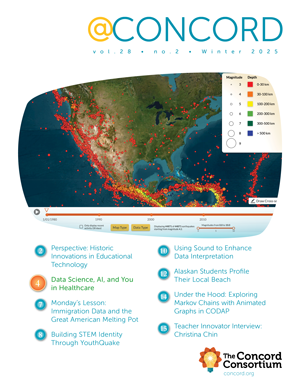Monday’s Lesson: Seeing Heat Transfer
“When I observe my students in traditional lab experiments versus simulated investigations online or a combination of the two, it’s evident that deeper connections are made with this generation [of students] when technology is utilized. It’s how they’re used to learning.” — Jennifer Aytes, 10th grade teacher, Kansas


Imagine if you could see the temperature of every surface in your house as a moving, colorful collage—red for hot pockets and currents of air, blue for cold, plus yellow and orange for rising and falling temperatures. This would allow you to follow the transfer of heat through the materials and the motion of warm and cold air throughout the building.
Our computational models allow you to do just that and more. They render dynamic heat flow with brightly colored temperature gradients, vectors and isothermals for both solids and fluids (Figure 1). Energy2D* is the only available heat transfer simulation that combines scientific accuracy with ease of use, making it perfect for STEM (science, technology, engineering and math) education. Students can create heat sources, walls, windows, sunlight and wind, and adjust the properties of the materials. And with all that colorful data at their fingertips, imagine the questions you could ask—and answer— about heat and heat transfer.
Developing and using models
The Next Generation Science Standards (NGSS) call for students to develop and use models as an essential scientific and engineering practice. Engineers use models to predict and test the designs of everything from houses and airplanes to bridges and nuclear reactors. Scientists use models to change parameters and explore scenarios— from quantum behavior and evolution to heat transfer and global warming.
Many model types are embedded in short classroom activities in our Innovative Technology in Science Inquiry: Scale Up (ITSI-SU) project, funded by the National Science Foundation. ITSI-SU assists teachers in preparing diverse students in grades 3-12 for STEM careers by engaging them in exciting, inquiry-based science and engineering activities that use computational models and real-time data collection. Teachers can create a class and enroll students in the ITSI-SU portal, then receive reports of all student work.
Engineering, technology and applications of science
In the ITSI-SU middle school engineering activity “Convection in a House,” students use Energy2D models to answer the question: How does air carry heat throughout a house? They explore natural and forced convection in carrying heat, as well as the effects on heat flow of blocking air in a two-dimensional house with walls, a roof, windows and a heater (Figure 2). They also measure the wind chill effect, experimenting with the cooling effect of moving air. Finally, students add and move barriers and create openings or closings to allow or block air flow.
The visible effects of these changes on heat transfer are immediate, allowing students to explore multiple variations in order to develop a picture—both intuitive and analytic—of heat flow. And while seeing may be believing, better yet, seeing can lead to understanding, especially when it comes to making the invisible—like heat and heat transfer—visible.
After students have a basic understanding of energy, challenge them to create a diagram that illustrates energy flow on any planet—with or without an atmosphere. The MySystem diagram in Figure 1 shows that the planet both absorbs the incoming sunlight and reflects some of it back into space. It radiates absorbed energy as infrared. The net change of energy on the planet is zero. All planets must do this or they would continue heating.
* Energy2D was developed by Charles Xie for the Engineering Energy Efficiency project.
Carolyn Staudt (cstaudt@concord.org) directs the ITSI-SU project.
Ed Hazzard (ehazzard@concord.org) is a science curriculum developer.
This material is based upon work supported by the National Science Foundation under grant DRL-0929540. Any opinions, findings, and conclusions or recommendations expressed in this material are those of the author(s) and do not necessarily reflect the views of the National Science Foundation.

